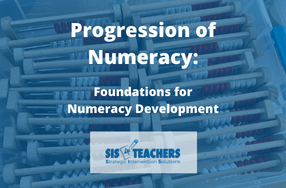Our math game tutorial library is growing! This week – more multiplication games!
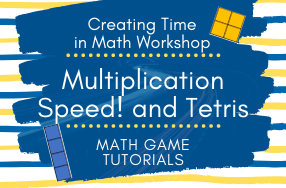
These multiplication game video tutorials are a great addition to 3rd, 4th, or 5th grade classrooms. Students use the video tutorials to learn to play the game on Monday. They can pause and rewatch as many times as they need to as they hash out the rules and what would happen in various possible scenarios of play, and then on Tuesday, they’re ready to play! And it didn’t take any of your time!
We all know we could use a little bit more time in our school day!

When working on multiplication, the number sequence matters and it isn’t in order! We start with x10 and x5, then x2, x4, and x8, then x3, x6, x9, and lastly, x7. This order helps students see patterns and learn multiplication on a deeper level than just memorization. This sequence also follows the sequence we use in our Multiplication Journals.
Multiplication Speed!
Materials:
- Speed! Deck. Choose from x2 through x9.
- We always recommend that, when you get the Speed! game, you order it in the sequence that we teach our multiplication facts: x5 would be first, then x2, x4, x8, then x3, x6, x9, then x7.
 Game Board. This isn’t required, but we have a free game board you can download which helps keep students organized as they play!
Game Board. This isn’t required, but we have a free game board you can download which helps keep students organized as they play!
This version of Speed is played very similarly to version you play with a regular deck of cards, except, instead of going in numerical order up or down, you’re counting by the deck of Speed cards you’re using to play. In the tutorial video, we’ll show two different games with different facts so that students can get the idea of how to play the game using our game board.
Each player gets dealt one-half of the deck. Players hold their half of the deck face down, and then flip over the first four cards in a row in front of them. Then, they each flip a card out into the space between the two rows to create the discard piles and the game begins!
Players can play one of their four face-up cards on either of the two discard piles in the middle. They can play a card that will either count up or down with the pattern of the deck. For example, if we’re playing x5 Speed and the cards in the middle are 10 and 25, players could play a 5, 15, 20, or 30 to continue the skip counting pattern either up or down.

The Speed! cards are unique in that they have a dot or bead pattern on them with the beads colored in groups by the factor of the deck. If I was using the x5 Speed deck and I was looking at the 25, there would be 5 groups of 5 circled. Some kids might need to use this feature in order to know what comes before or after the number they’re looking at in the discard piles in the middle.
Once one of the four face-up cards is played, players will flip another card out from the deck in their hands to make sure they always have four cards ready to play. The first player to play all his or her cards is the winner!
A Few “House Rules”
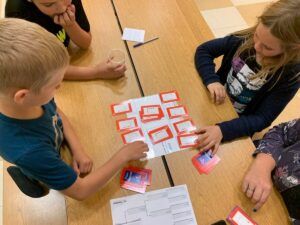 If both players are stuck, where neither player has the card that they need to go up or down by the Speed level on the cards in the middle, they can each play a card from their hand into the middle to “reset” the decks.
If both players are stuck, where neither player has the card that they need to go up or down by the Speed level on the cards in the middle, they can each play a card from their hand into the middle to “reset” the decks.
If one player has four or less cards left, with no cards in their hands to be able to help reset the deck, take the discard piles in the middle, flip them over and take the top card to put back in the middle.- For example if we were playing Speed x5 and the two cards in the middle are 20 but neither of us has a 15 or a 25 in our four face-up cards to play, we could each flip a new card over into the middle and continue to play.
- We don’t usually require students to say “Speed” at the end to win the game. In traditional play, if you don’t say “Speed” you have to pick up two cards from the discard piles and continue to play. However, since we play a little more open-faced so players can watch each others’ moves, it’s not really necessary. It is something the teacher could definitely add if they wished, however.
- Additionally, when we’re playing in schools, we don’t require students to say “Speed” to win because it can quickly escalate into an argument of who said it first and we’re trying to SAVE time, not create opportunities for argument!
Tournament Style
Kids love playing this in a tournament style! We have an “Elite 8” bracket you can download (click here or click the image) and use for your class. This is really fun in a parent night too, where parents learn to play and then get the Speed! game to take home to play with their child.
Multiplication Tetris
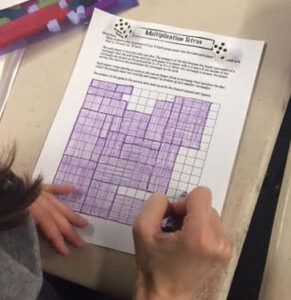 The reason I like this game is that it moves us beyond just talking about facts. Multiplication Tetris actually starts getting kids to understand the commutative property of multiplication where we can talk about 6 groups of 5 or 5 groups of 6 and show how the array can take up different configurations of space.
The reason I like this game is that it moves us beyond just talking about facts. Multiplication Tetris actually starts getting kids to understand the commutative property of multiplication where we can talk about 6 groups of 5 or 5 groups of 6 and show how the array can take up different configurations of space.
Multiplication Tetris is very similar to the problem solving game we are familiar with as adults. With regular Tetris, you are trying to neatly compact shapes into available space, rotating shapes to ensure they take up the space most efficiently.
This is a great game for students that are in the beginning phases of understanding decomposing with multiplication or are starting to go into partial products with the area model.
Materials:
- Colored pencils. Not required – some kids do it with one color, some like to make it more colorful.
- 1 set of 6-sided dice per player. When students are just learning how to play, I prefer to have just one set of dice so that they can watch each other take their turns. Once they are proficient and confident, each player can have their own set of dice.
- Note: To increase the difficulty, you could also use 10- or 12-sided dice.
 1 Game Board per player. Download our free game board here, or create your own. We use a 15 x 15 grid, but you could make it larger to make it more complicated as students advance.
1 Game Board per player. Download our free game board here, or create your own. We use a 15 x 15 grid, but you could make it larger to make it more complicated as students advance.
- Some classrooms will laminate or put this game board into a clear sleeve and use dry erase markers so they can reuse the game board. I personally make this a single-use game and print a copy for every student every time. This way, students can take their game boards home to show parents and explain how to play to their families. We’ve also included this game in parent nights before, and then each parent gets three copies of the game board – two to use that night to play with their child, and one can be copied to play again at home.
Players:
At least two players are required, but you could have three or more. I’ve played with a whole table group as well, and you could also make it a classroom-wide competition.
Objective:
Each player is trying to fill in their own individual game board as neatly as possible, and the player with the lowest number of spaces left at the end of the game wins.
- Roll the dice. When learning, players should take turns rolling the dice. Once players are proficient, they can roll and play at their own pace.
- Take the two numbers on the dice as factors and make an array with those two factors.
- Decide where on the board to place the array. Consider the commutative property of the factors might provide a more convenient shape. Irregular shapes are not allowed.
- If I rolled a 5 and a 6, the total area will be 30. I could do 5 rows of 6 or 6 rows of 5.
- Shade in the squares that make up that array and write the product inside the square.
- Play until students are unable to place any arrays on their game board.
- Count how many empty spaces are left on the game board. This could range from higher numbers to one square left (which I saw happen once!). As students repeatedly play this game, they start to discover and strategize on where they’re putting their area and if they want to use that commutative property to turn it based on the space available.
Strategy
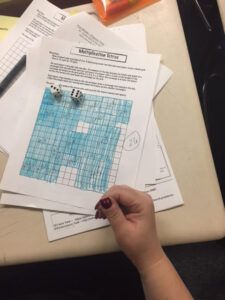
The winning player is the one who can most strategically cover their space. The 8 mathematical practices come into play as kids are building their arrays as they have to be strategic in their thinking. Where are they going to place that area in conjunction with what they’ve already placed on their board? Which arrangement will be most advantageous? Do they start building from the bottom of the board? Maybe they start building larger shapes (multiples of higher numbers like 5 and 6) in one corner and smaller shapes in the another?
Multiplication Tetris is also simple enough that you could take it to a restaurant for when kids need something to do while they wait. Why not work on multiplication?
Multiplication Tetris could be used in 3rd, 4th, or 5th grade. It’s a great game for kids to use to use as a review of their skills in multiplication. Raise the differentiation level with different sided dies or a larger grid, but be sure you don’t make the grid or the dice too big that students struggle with larger shapes.
Accountability Sheets
If you were doing a tournament, the bracket would let you know things were happening in the classroom, but students might want to keep score so they might use some other paper to do so. Obviously, the students are playing Multiplication Tetris, the game board itself is proof that they were actually playing. Students can turn that game board in as a symbol that they’ve completed the game.
These are two other great games that you can add to your repertoire of multiplication games.
Want more multiplication games? Check out last week’s blog. Want more video tutorials in other areas? Go to our Video Tutorials page!
What games or concepts would you love to have a video tutorial for to use with your students? Drop it in the comments!


